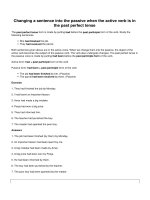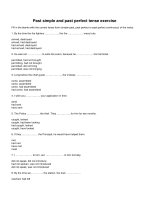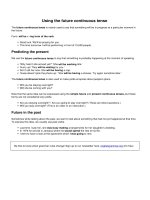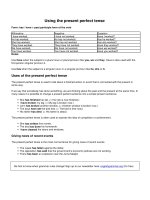Using the past perfect tense
Bạn đang xem bản rút gọn của tài liệu. Xem và tải ngay bản đầy đủ của tài liệu tại đây (11.29 KB, 1 trang )
Using the past perfect tense
Form:
Affirmative Interrogative Negative
I had worked. Had I worked? I had not worked.
She had played. Had she played? She had not played.
It had rained. Had it rained? It had not rained.
They had waited. Had they waited? They had not waited.
You had promised. Had you promised? You had not promised.
As you can see in the
past perfect tense,
the auxiliary verb
had
is used with both singular and plural nouns.
Uses
The past perfect tense is not usually used alone. It is mainly used with the simple past tense and then it refers to
an action that has already happened by the time another action had commenced.
The patient
had died
before the doctor arrived. (NOT The patient died before the doctor had arrived.)
We use the past perfect tense for the earlier of the two past actions.
The train
had left
before we reached the station. (NOT The train left before we had reached the station.)
I
had cooked
the meals before the kids came home from school.
I
had finished
one project before I started the next.
In many cases we can use time conjunctions lik
e before
and
after
to indicate that one action had taken place
before another commenced. The use of past perfect tense is optional in this case. That means you can use it but
it is not necessary.
After
he
finished
the project he went to Australia for a month.
OR
After
he
had finished
the project he went to Australia for a month.
Note that the past perfect tense is only used as described above. It is not used to simply say that something
happened some time ago.
I met an old friend of mine yesterday. (NOT I had met an old friend of mine yesterday.)
Be first to know when grammar rules change! Sign up to our newsletter here: englishgrammar.org (It's free)
Powered by TCPDF (www.tcpdf.org)









